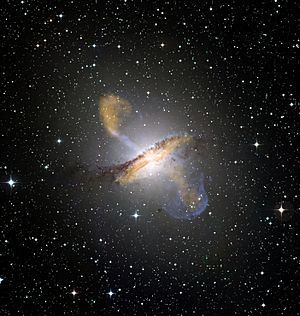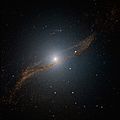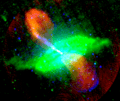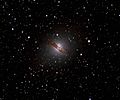Centaurus A facts for kids
Quick facts for kids Centaurus A |
|
|---|---|

Centaurus A (NGC 5128)
|
|
| Observation data (J2000 epoch) | |
| Constellation | Centaurus |
| Right ascension | 13h 25m 27.6s |
| Declination | -43° 01′ 09″ |
| Redshift | 547 ± 5 km/s |
| Distance | 10–16 Mly (3–5 Mpc) |
| Type | S0 pec or Ep |
| Apparent dimensions (V) | 25′.7 × 20′.0 |
| Apparent magnitude (V) | 6.84 |
| Notable features | Unusual dust lane |
| Other designations | |
| NGC 5128, Arp 153, PGC 46957, 4U 1322–42, Caldwell 77 | |
| See also: Galaxy, List of galaxies | |
Centaurus A or NGC 5128 is a prominent galaxy in the constellation of Centaurus. It was discovered in 1826 by Scottish astronomer James Dunlop at his home in New South Wales, Australia.
NGC 5128 is either a Hubble type lenticular galaxy or a elliptical galaxy. It is 10–16 million light-years away.
NGC 5128 is one of the closest radio galaxies to Earth. Its active center has been well studied. The galaxy is the fifth brightest in the sky, and is an ideal amateur astronomy target. The galaxy is only visible from low northern latitudes and the southern hemisphere.
Spitzer Space Telescope studies have confirmed that Centaurus A is colliding with, and devouring, a smaller spiral galaxy. Like other starburst galaxies, the collision produced the intense burst of star formation.
The center of the galaxy has a supermassive black hole. Its mass is about 55 million solar masses. This ejects a relativistic jet with emissions in the X-ray and radio wavelengths. Astronomers have taken radio observations of the jet ten years apart. They found that the inner parts of the jet are moving at about half the speed of light. X-rays are produced further out as the jet collides with surrounding gas. This produces highly energetic particles. The radio jets of Centaurus A are over a million light years long.
Visibility
Centaurus A is located approximately 4° north of Omega Centauri (a globular cluster visible with the naked eye). Because the galaxy has a high surface brightness and relatively large angular size, it is an ideal target for amateur astronomy observations. The bright central bulge and dark dust lane are visible even in finderscopes and large binoculars, and additional structure may be seen in larger telescopes. Centaurus A is visible to the naked eye under exceptionally good conditions.
Images for kids
-
The radio galaxy Centaurus A, as seen by ALMA
-
The heavily obscured inner (barred?) spiral disk at 24 μm as shown by the Spitzer IR telescope
-
Chandra X-ray view of Cen A in X-rays showing one relativistic jet from the central black hole
-
"False-colour image of Centaurus A, showing radio (red), 24-micrometre infrared (green) and 0.5–5 keV X-ray emission (blue)
See also
 In Spanish: Centaurus A para niños
In Spanish: Centaurus A para niños











